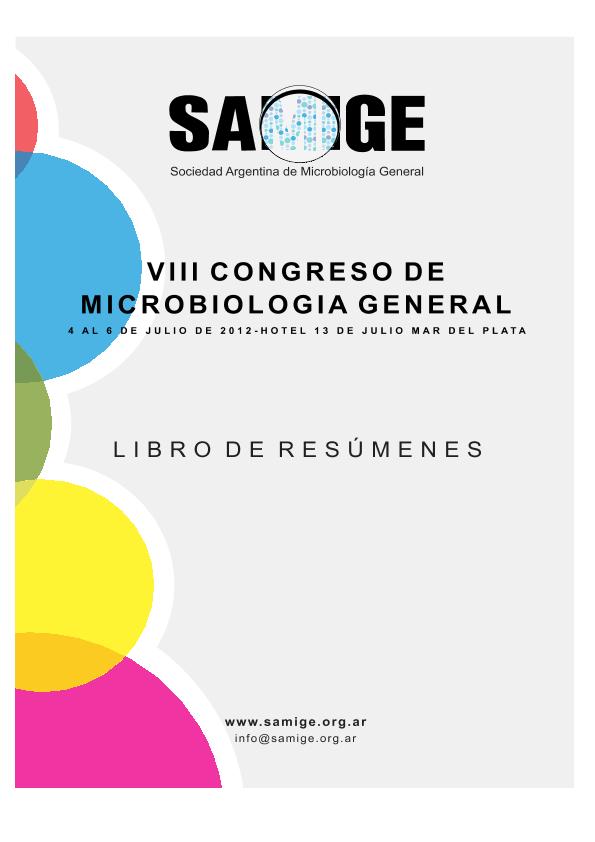Mostrar el registro sencillo del ítem
dc.contributor.author
Ordoñez, Omar Federico

dc.contributor.author
Kurth, Daniel German

dc.contributor.author
Turjanski, Adrian

dc.contributor.author
Vázquez, Martin
dc.contributor.author
Farias, Maria Eugenia

dc.contributor.author
Cortez, Nestor Ricardo

dc.date.available
2023-04-21T14:54:16Z
dc.date.issued
2012
dc.identifier.citation
Genome sequence analysis of bacteria highly tolerant to arsenic, isolated from High Altitude Andean Lakes (HAAL); VIII Congreso argentino de Microbiología General; Mar del Plata; Argentina; 2012; 133-133
dc.identifier.uri
http://hdl.handle.net/11336/194925
dc.description.abstract
High Altitude Andean lakes (HAAL) comprise a system of shallow lakes formed during the tertiary period (1.8-65 million years ago) distributed across the Puna (high plateau) at altitudes varying from 4,200 m to 6,000 m above sea level (asl). These aquatic ecosystems present extreme environmental conditions such as high levels of Ultraviolet Radiation (UVR), a wide range of salinity (from 0.4 to 117 ppm), large daily temperature fluctuations ranging from 20° C to -40° C, low nutrient concentrations and the presence of heavy metals and metaloids, mainly arsenic. The presence of arsenic resistance mechanisms has been explored in several microbiological studies in arsenic-rich environments. The most characterized arsenic resistance mechanism is the ars operon located either in plasmids or chromosomes of prokaryotes. Bacterial As detoxification involves the reduction of arsenate (As[V]) to arsenite (As[III]) via a cytoplasmic arsenate reductase (arsC). Later on As[III] will be extruded by a membrane-associated ArsB efflux pump. Other genes like arsR, arsD and arsA form part of ars operon along with arsB and arsC in most of the As tolerant prokaryotes. HAAL isolates show enhanced resistance compared to other bacteria carrying the ars operon. This could be explained by the presence of additional genes related to this function, including extra copies of the ars operon or supplementary extrusion pumps. The aim of this study was to elucidate the genetic mechanisms of tolerance to high arsenic concentrations, taking advantage of the available genomes of three UV resistant bacterial strains, recently isolated from HAAL extreme environments. Moreover, the presence of the ACR3 gene as a possible resistance mechanism was assessed by degenerate oligonucleotides. We studied the strains Acinetobacter sp. Ver3 and Exiguobacterium sp. N30 and S17, isolated from shallow water (Laguna Verde and Laguna Negra), and from modern stromatolites (in Laguna Socompa) respectively. Maximal arsenic concentration was 33.81 mg/L. Genome sequences were obtained using a whole-genome shotgun strategy with a 454 GS Titanium pyrosequencer at INDEAR, Argentina. Genomes were annotated and analyzed in the RAST annotation server. PSI-BLAST and ClustalW were used to compare and align sequences, and phylogenetic trees were built using Mega5. The effect of As[V] and As[III] during growth in rich media was also evaluated by different protocols. The strains Exiguobacterium arantiacum DSMZ 6208 and Acinetobacter baumannii DSM 30007 were used as controls during tolerance profiles measurements. Organisms with high tolerance to this metalloid, isolated in pure culture from environments such as HAAL, could be good candidates for studies of bioremediation of metals and metalloids, a methodology considered of low cost and environmentally friendly.
dc.format
application/pdf
dc.language.iso
eng
dc.publisher
Sociedad Argentina de Microbiología General
dc.rights
info:eu-repo/semantics/openAccess
dc.rights.uri
https://creativecommons.org/licenses/by-nc-sa/2.5/ar/
dc.subject
GENOME SEQUENCE
dc.subject
ANDEAN LAKES
dc.subject
ARSENIC
dc.subject.classification
Biología Celular, Microbiología

dc.subject.classification
Ciencias Biológicas

dc.subject.classification
CIENCIAS NATURALES Y EXACTAS

dc.title
Genome sequence analysis of bacteria highly tolerant to arsenic, isolated from High Altitude Andean Lakes (HAAL)
dc.type
info:eu-repo/semantics/publishedVersion
dc.type
info:eu-repo/semantics/conferenceObject
dc.type
info:ar-repo/semantics/documento de conferencia
dc.date.updated
2023-04-11T12:10:09Z
dc.journal.pagination
133-133
dc.journal.pais
Argentina

dc.description.fil
Fil: Ordoñez, Omar Federico. Consejo Nacional de Investigaciones Científicas y Técnicas. Centro Científico Tecnológico Conicet - Tucumán. Planta Piloto de Procesos Industriales Microbiológicos; Argentina
dc.description.fil
Fil: Kurth, Daniel German. Consejo Nacional de Investigaciones Científicas y Técnicas. Centro Científico Tecnológico Conicet - Tucumán. Planta Piloto de Procesos Industriales Microbiológicos; Argentina
dc.description.fil
Fil: Turjanski, Adrian. Consejo Nacional de Investigaciones Científicas y Técnicas. Oficina de Coordinación Administrativa Ciudad Universitaria. Instituto de Química Biológica de la Facultad de Ciencias Exactas y Naturales. Universidad de Buenos Aires. Facultad de Ciencias Exactas y Naturales. Instituto de Química Biológica de la Facultad de Ciencias Exactas y Naturales; Argentina
dc.description.fil
Fil: Vázquez, Martin. Consejo Nacional de Investigaciones Científicas y Técnicas. Centro Científico Tecnológico Rosario. Instituto de Agrobiotecnología de Rosario; Argentina
dc.description.fil
Fil: Farias, Maria Eugenia. Consejo Nacional de Investigaciones Científicas y Técnicas. Centro Científico Tecnológico Conicet - Tucumán. Planta Piloto de Procesos Industriales Microbiológicos; Argentina
dc.description.fil
Fil: Cortez, Nestor Ricardo. Consejo Nacional de Investigaciones Científicas y Técnicas. Centro Científico Tecnológico Conicet - Rosario. Instituto de Biología Molecular y Celular de Rosario. Universidad Nacional de Rosario. Facultad de Ciencias Bioquímicas y Farmacéuticas. Instituto de Biología Molecular y Celular de Rosario; Argentina
dc.relation.alternativeid
info:eu-repo/semantics/altIdentifier/url/https://samige.org.ar/wp-content/uploads/2022/10/Libro-SAMIGE-2012.pdf
dc.conicet.rol
Autor

dc.conicet.rol
Autor

dc.conicet.rol
Autor

dc.conicet.rol
Autor

dc.conicet.rol
Autor

dc.conicet.rol
Autor

dc.coverage
Internacional
dc.type.subtype
Congreso
dc.description.nombreEvento
VIII Congreso argentino de Microbiología General
dc.date.evento
2012-07-04
dc.description.ciudadEvento
Mar del Plata
dc.description.paisEvento
Argentina

dc.type.publicacion
Book
dc.description.institucionOrganizadora
Sociedad Argentina de Microbiología General
dc.source.libro
VIII Congreso Argentino de Microbiología General
dc.date.eventoHasta
2012-07-06
dc.type
Congreso
Archivos asociados
